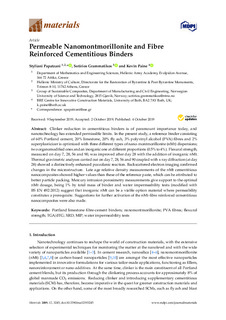| dc.contributor.author | Papatzani, S. | |
| dc.contributor.author | Grammatikos, Sotirios | |
| dc.contributor.author | Paine, K. | |
| dc.date.accessioned | 2020-02-17T15:06:44Z | |
| dc.date.available | 2020-02-17T15:06:44Z | |
| dc.date.created | 2019-11-18T18:18:12Z | |
| dc.date.issued | 2019 | |
| dc.identifier.citation | Materials. 2019, 12 (19), 1-21. | nb_NO |
| dc.identifier.issn | 1996-1944 | |
| dc.identifier.uri | http://hdl.handle.net/11250/2642075 | |
| dc.description.abstract | Clinker reduction in cementitious binders is of paramount importance today, and nanotechnology has extended permissible limits. In the present study, a reference binder consisting of 60% Portland cement, 20% limestone, 20% fly ash, 3% polyvinyl alcohol (PVA) fibres and 2% superplasticizer is optimized with three different types of nano-montmorillonite (nMt) dispersions; two organomodified ones and an inorganic one at different proportions (0.5% to 4%). Flexural strength, measured on day 7, 28, 56 and 90, was improved after day 28 with the addition of inorganic nMt. Thermal gravimetric analyses carried out on day 7, 28, 56 and 90 coupled with x-ray diffraction (at day 28) showed a distinctively enhanced pozzolanic reaction. Backscattered electron imaging confirmed changes in the microstructure. Late age relative density measurements of the nMt cementitious nanocomposites showed higher values than these of the reference paste, which can be attributed to better particle packing. Mercury intrusion porosimetry measurements give support to the optimal nMt dosage, being 1% by total mass of binder and water impermeability tests (modified with BS EN 492:2012) suggest that inorganic nMt can be a viable option material where permeability constitutes a prerequisite. Suggestions for further activation of the nMt-fibre reinforced cementitious nanocomposites were also made. | nb_NO |
| dc.language.iso | eng | nb_NO |
| dc.publisher | MDPI | nb_NO |
| dc.rights | Navngivelse 4.0 Internasjonal | * |
| dc.rights.uri | http://creativecommons.org/licenses/by/4.0/deed.no | * |
| dc.title | Permeable nanomontmorillonite and fibre reinforced cementitious binders | nb_NO |
| dc.type | Journal article | nb_NO |
| dc.type | Peer reviewed | nb_NO |
| dc.description.version | publishedVersion | nb_NO |
| dc.source.pagenumber | 1-21 | nb_NO |
| dc.source.volume | 12 | nb_NO |
| dc.source.journal | Materials | nb_NO |
| dc.source.issue | 19 | nb_NO |
| dc.identifier.doi | 10.3390/ma12193245 | |
| dc.identifier.cristin | 1749070 | |
| dc.description.localcode | © 2019 by the authors. Licensee MDPI, Basel, Switzerland. This article is an open access article distributed under the terms and conditions of the Creative Commons Attribution (CC BY) license (http://creativecommons.org/licenses/by/4.0/). | nb_NO |
| cristin.unitcode | 194,64,94,0 | |
| cristin.unitname | Institutt for vareproduksjon og byggteknikk | |
| cristin.ispublished | true | |
| cristin.fulltext | original | |
| cristin.qualitycode | 1 | |

